Van Gogh Museum Journal 2001
(2001)– [tijdschrift] Van Gogh Museum Journal–
[pagina 44]
| |
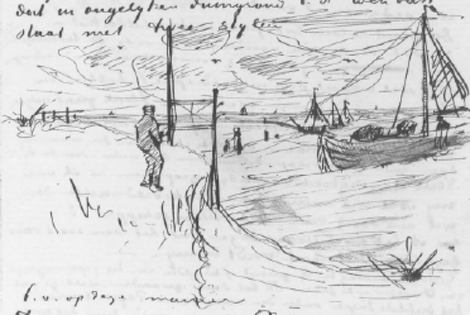 fig. 1a-b
Van Gogh's perspective frame, sketches from letters 222/254 and 255/223, 1882 | |
[pagina 45]
| |
Framing art and sacred realism: Van Gogh's ways of seeing Arles Debora SilvermanGa naar voetnoot+In late February of 1888, Vincent van Gogh journeyed from Paris to the Provençal town of Arles. We do not know precisely why he chose Arles; he registers only a vague awareness of the region. He had read novels and stories by Alphonse Daudet, whose works evoked local sites and figures - such as the windmill on the road from Arles to Fontvieille in Letters from my windmill. He may have seen a festival staged in an 1887 Paris exhibition featuring Arlesian costume and the special Provençal dance, the farandole. Van Gogh seems to have set off with a composite picture of his destination in mind, stimulated mainly by a quest for the warm sun of the south. This composite drew on disparate sources of literary prototypes, interest in the Marseilles-born painter Alphonse Montecelli and in Eugène Delacroix's Mediterranean journey, and in the brightly coloured world depicted in the profusion of Japanese prints Van Gogh had collected in Paris.Ga naar voetnoot1 Prepared then by these diverse sources, Van Gogh went to Provence in search of what he called light, warmth and ‘tranquillity.’ Stepping off the train at Arles, however, he was greeted not by the restorative sun of the south, but by similar weather conditions he had hoped to leave behind in frosty Paris: snow was falling, with freezing temperatures. Nonetheless, the clarity of the air, the ramparts of the town centre edged by the Rhône, and the vistas of broad, flat stretches of planted fields still offered him a striking contrast to the Parisian metropolis. His first reactions, recorded in a letter to Theo, linked Arles with Holland and Japan. At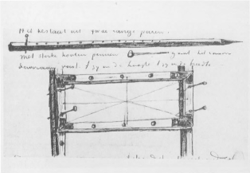 first glance he had thought of a Dutch town and noted: ‘Arles doesn't seem to me any bigger than Breda [...].’ Breda, the Brabant home of Van Gogh's grandparents, was, like Arles, a town with intact ramparts, bordered by water and flat panoramic landscapes. At the same time, Van Gogh noticed the mountains marking the distant horizon, and described the spectacle of the countryside terminating in snow-covered summits as ‘just like the winter landscapes that the Japanese have painted’ [579/463]. A Japanese ukiyoe print come alive, a Dutch panoramic topography - these first recorded associations set the tone and the limits of Van Gogh's early assimilation of his new French environment. | |
[pagina 46]
| |
Contrary to our mythic view of an immediate and uninhibited enthusiasm for the sun-saturated south, Van Gogh's encounter with Provence was both vexed and scrupulously controlled and he made an extensive and strenuous effort to transform, negate and neutralise the dimensions of Arles culture he found unfamiliar or disturbing. Particularly unsettling to Van Gogh, a former theology student trained in the new doctrine of Dutch Reformed ‘anti-supernaturalism,’ were the pervasive and public practices of Arlesian Catholicism, which exalted a tormented Christ and a panoply of martyred saints who were called upon in festive and devotional celebrations to intercede in the structures of rural life and the cycles of rural production. Much of Van Gogh's work in the Arles period can be interpreted as an attempt to come to terms with this dynamic Catholic culture, one that began by his excising it altogether from view and moved, by the end of his stay, towards developing an alternative imagery of modern consolation to replace the cult of miracles, martyrs and saintly protectors so dominant in the visual culture around him. This article traces three aspects of Van Gogh's early months in Arles: first, it examines the way he responded to fields, canals and drawbridges with memories of the Netherlands, selecting those Arlesian elements that bore closest affinity to Dutch topography and motifs; second, the way he approached this repertoire of subjects by re-engaging with the tools and techniques developed during his Dutch apprenticeship, especially by returning to the regular use of the perspective frame; and third, the way he pursued drawing experiments at the important pilgrimage site of Montmajour, experiments that highlight the disparity between his own mental and visual habits and the world of an exultant, form-giving Catholicism and exclusivist regionalist politics. The article concludes by identifying the development of what can be called Van Gogh's sacred realism, characterising it as a response to the dual challenge posed by avant-garde art and populist French Catholicism in 1888. | |
Tourist Arles, 1888Arles was renowned for a number of features that elicited very little, if any, verbal or visual response from Vincent van Gogh. An important Roman capital and port city founded by Julius Caesar, the town preserved major monuments of Gallo-Roman antiquity, such as the massive first-century amphitheatre, the Arènes, built to hold 20,000 people, and emerged during the mid-19th century as a tourist site for ancient art and architecture. Sacred buildings and relics of early Christian civilisation overlay Roman Arles to enhance its reputation as part of what was called the ‘elite of French national monuments.’Ga naar voetnoot2 By the 1880s regional scholars had collected numerous documents that chronicled the town's special status as ‘the holy city on the Rhöne.’ An archbishopric until 1801, Arles had outstripped the papal city of Avignon with its profusion of convents and churches. Here each neighbourhood was organised under its own patron saint and saint's chapel - from St Isodore, protector of the field workers, to St Vincent, patron saint of the wine growers.Ga naar voetnoot3 Arles occupies a prominent position in the legends and early histories of Christianisation which were systematically compiled and republished from the mid-19th century onwards. According to these traditions, St Martha, sister of Mary Magdalene, had journeyed to Arles with St Trophimus and together they had converted the local people to Christianity by miraculously causing a sculpture of a pagan goddess to topple to the ground. These same legends placed two Marys - les Saintes Maries - and their servant Sarah in a boat that had carried them from Judea and had landed miraculously, without sail or oar, along the coast of the Camargue; from there they disembarked and set out to evangelise Provence. Every year, on 24 May, pilgrims travelled to the Camargue to commemorate the miraculous landing of the women saints and to glorify their continuing thaumaturgical powers. Thousands of worshippers arrived at the church of Saintes-Maries-de-la-Mer to witness the annual lowering of the relics from the belfry tower shrine | |
[pagina 47]
| |
and to parade to the beach carrying elaborately decorated statuettes of the saints in their model boat. Surrounded by a flotilla of garlanded fishing vessels, the Marys were launched into the waters of the Mediterranean, symbolically re-enacting their miraculous arrival and re-confirming their concrete spiritual presence in the lives of the faithful.Ga naar voetnoot4 The legend of St Trophimus is inscribed on the portal of the cathedral bearing his name in the centre of Arles, which also houses his relics. The cathedral's 12th-century carved doorway, tympanum and cloisters shaped its reputation as one of the finest Romanesque churches in Provence. Outside the Arles town walls to the southeast lies the ancient necropolis known as Les Alyscamps. Originally a Roman burial ground positioned along the Aurelian way, the early Christians consecrated the Alyscamps and from the 4th through the 13th centuries it was a locus of miracles and the resting place of many important saints. According to the 13th-century chronicles recovered in the 19th century, the Alyscamps was so important for Christian burial that citizens from as far away as Avignon would ‘place a corpse of some beloved dead into a coffin, fashioned like a barrel, and commit it to the Rhöne.’ Floated downstream and containing money to pay the funeral expenses, these travelling biers were said to always have arrived safely at their final destination, unaided by human hands and undisturbed by robbers.Ga naar voetnoot5 By the end of the 13th century the Alyscamps encompassed thousands of tombs and sarcophagi piled up on several levels. Nineteen churches and chapels dotted the grounds, housing saints' remains and relics in their crypts. Although the Alyscamps languished soon afterward, two of the original chapels survived and continued to function as pilgrimage sites into the late 19th century. One was the Chapelle de la Genouillade, built on the spot where, according to legend, Christ had left an imprint of his knee when he miraculously appeared to the first bishop of Arles and the assembled Christian congregation to bless the newly consecrated necropolis. The Chapelle de St Honorat also remained intact in the 1880s, marking the Alyscamps with a prominent, illuminated bell tower locally known as the lanterne des morts. On 1 November, the eve of the festival of Toussaint - All Saints - Arlesians attending midnight mass expected Christ to return to the Alyscamps, where he would seek out and resurrect all the town's saints and convene them, in the presence of the angels, to recite the mass of the dead.Ga naar voetnoot6 | |
Dutch affinitiesNeither the historical spectacle of Roman and Christian Arles nor contemporary Arlesian Catholic culture held any appeal for Vincent van Gogh. To be sure, he took note of the ‘priest in his surplice’ and the Arlésiennes in their distinctive regional costumes and traditional headdresses en route to Saint-Trophime for Communion. Yet the artefacts of Roman imperial power and the representations of Christian judgment seemed to him somehow bizarre: ‘There is a Gothic portico here, [...] the porch of St Trophime. But it is so cruel, so monstrous, like a Chinese nightmare, that even this beautiful example of so grand a style seems to me to belong to another world, and I am as glad not to belong to it as to that other world, [...] of the Roman Nero’ [589/470]. While Van Gogh was repelled by Arles' medieval and Roman culture, he was enthralled with the Arlesian landscape. Exploring the countryside around the town he was inundated by a profusion of associations with rural Holland, the world to which he had belonged ‘before Paris and the impressionists.’ During his first months in Arles Van Gogh constructed what he called an allegiance to a ‘second fatherland’ [708/552] out of this projection of affinities with his first Netherlandish homeland, developing a visual repertoire of subjects that to him were ‘exactly like Holland in character’ [612/488]. There were indeed powerful similarities between some features of the Arles environment and the Dutch physical world that struck and delighted Van Gogh. Like | |
[pagina 48]
| |
the painstakingly crafted Dutch terrain, the environs of Arles were a kind of constructed nature, slowly consolidated by the continuous process of reclaiming land from the sea. In the late 19th century the term ‘hydrographic régime,’ most commonly associated with the Netherlands, was also used to characterise the topography of Arles and its forms of cultivation. Named Arles by the Romans in derivation from Arelate - ‘city of swamps’ or ‘place of the waters’ - the town was originally a waterlogged marshland, secured to a cultivable base only by relentless drainage and irrigation. Beginning in the 15th century the area surrounding Arles to the southeast - the marsh of La Crau - was progressively transformed from a soggy swamp into a broad, flat plain suitable for growing wheat and vines, and for grazing. To complete the reclamation, in the late 17th century the Arles town councillors enlisted the services of a Dutch engineer, Van Hens, a representative of that envied ‘nation of Penelopes,’ described as skilled weavers of dry acreage from a liquid base.Ga naar voetnoot7 While La Crau was thus partially transformed into farm and grazing land, the vast domain to the southwest of Arles, the Camargue, remained throughout the 19th century a sparsely inhabited marshland filled with bogs and low lying dunes not unlike parts of Drenthe and Zeeland in the Netherlands. Camille Mauclair, travelling through Provence late in the century, compared the ‘desolate and captivating’ alternation of lagoons and dunes in the Camargue to ‘the Dutch polders,’ an area ‘neither land nor sea,’ ‘like Moerdyk, the banks of the Zuyderzee and Texel.’Ga naar voetnoot8 Nonetheless, 19th-century Provençal engineers, as resourceful and persistent as their Dutch counterparts, continued to devise elaborate schemes for draining, pumping and reclaiming land in the Camargue, and between 1850 and 1910 they created ‘around 50 square kilometres of arable land.’ Taking the 19th century as a whole, at least 364 were recuperated in the Arles, Crau and Camargue areas by what one writer called the ‘tenaciousness of those who extracted land [...] from the swamps, mastering the Rhöne and fertilising the most obdurate soils of the terrain.’Ga naar voetnoot9 These reclamation schemes necessitated the digging of a series of canals, so prominent a feature of Dutch topography, which began to slice through Arles and the surrounding countryside in the 16th century, channelling the waters along drainage corridors and creating a network of linear perspectives and recessional frames within the landscape. The Canal de Craponne, for example, bordered Arles to the southeast, near Les Alyscamps; another archaic canal, the Roubine du Roi, still compelled residents and visitors in the 19th century to cross a recessed waterway in order to reach the Arles town centre, as its embankment ran right up to the main gates of the town at the Porte de la Cavalerie. Like the unremitting challenge to the Dutch Waterstaat, Arles' water management project was additive and new waterways were continually appended to the older network. During the 19th century the most significant of these was a canal stretching from Arles to the town of Bouc on the Mediterranean. Along it were a number of bridges and locks, the first one, the Pont de Réginelle - known in Van Gogh's time as the Pont de Langlois - lying just outside Arles to the southwest.Ga naar voetnoot10 Along with a landscape carved out and protected from the waters, the town and its environs were, like the Netherlands, still very vulnerable to inundation. In the year preceding Van Gogh's move to Arles, numerous Parisian newspapers, periodicals and illustrations recorded the devastating flood on the Rhöne in late 1886. Van Gogh was probably aware of the damage to the areas around Arles and Avignon through his reading of the 26 December 1886 special issue of the Courrier Français, which reported the disaster of the deluge and solicited support ‘for the unfortunate flood victims of the Midi.’Ga naar voetnoot11 When Van Gogh arrived in Arles in 1888, then, he encountered a surprisingly familiar world that in many respects could indeed be said to ‘remind one of Holland.’ He discovered in Arles and its environs a Dutch-like world of | |
[pagina 49]
| |
wooden drawbridges, windmills and dunes; of ‘cane fences’ and ‘thatched roofs’ [633/W4]; of canals and marshes; of flat, expansive fields, ‘infinite as the sea’ [643/509], yielding to remote horizons in ‘panoramic breadth’ [617/492]. On the immediate outskirts of the town he would have passed through the neighbourhood of Les Mouleyrès, named after its many windmills; each windmill had its own name, the one on the Rue Mireille being called the ‘Moulin de la Mousmée.’ As he walked from the train station to the Porte de la Cavalerie, Van Gogh would have crossed the Roubine du Roi, where local women sat on makeshift rafts in the waters doing their washing, laying out the linens and garments to dry along the embankments. This spectacle of the canal and its activities would always appear in clear view from the windows of the Yellow House, which Van Gogh rented in Septemberand that fronted on the Place Lamartine, opposite the Roubine and the city gate. Linensplayed grounds in canal-lined landscapes evoked the scene depicted in one of Van Gogh's favourite Dutch paintings, Ruysdael's View of Haarlem, and also recalled the view of the bleaching fields behind the Van Gogh family's parish house in Zundert. Further, the laundresses' floating wooden platforms, with their visible interlocking slats and bracing posts sunk into the canal bed, resembled the fleet of Dutch wickerwork rafts known as zinkstukken which were a common feature along the canals of southern Holland and were used as staging platforms for bracing the ever-permeable sea walls.Ga naar voetnoot12 To be sure, although encouraged to ‘keep thinking of Holland,’ Van Gogh also acknowledged the powerful contrasts between Arles and the Dutch countryside. The ‘bright, clear colours’ and radiant light of the south offered a very different spectacle than what he called the effects of colours ‘veiled in the mist of the north.’ The unfolding of expansive, level plains to a distant convergence at a remote horizon, for example, allowed him to see clearly the colour and definition of things ‘far, far in the distance,’ rather than merely the ‘vague,’ indefinite ‘grey line on the horizon’ so typical of Holland. Van Gogh defined this precision and saturation of colours created by the strong southern sun as the ‘equivalent’ of the brilliant sunlit colourism of the Japanese, claiming as he settled in to live in Arles that he was now ‘in Japan’ [681/W7]: ‘Here I am in Japan,’ he wrote to Theo; I am beginning to see things with an eye more Japanese,’ to ‘feel colour differently’ [802/605].Ga naar voetnoot13 | |
Van Gogh's tool kit: the perspective frameVan Gogh's readiness to see Arles through a Japanese eye was tempered, however, by his Dutch ways of seeing and his enduring preoccupation with art, craft and work. Soon after arriving in Arles he resumed regular use of a tool he had first constructed in The Hague in 1882: his perspective frame. This oblong wooden frame, strung with lengths of thread into the pattern of a Union Jack, could be attached to adjustable notches on two wooden poles and staked into the ground for outdoor sightings. Looking through it like a window, the artist trains himself to compare the proportion of objects nearby with those on a more distant plane, while the intersection of the threads presses the eye to its point of convergence at the vanishing point (figs. 1a-b). Adapted from his study of 19th-century popular art manuals, Van Gogh's frame was a formative resource throughout his Dutch period. It allowed him both to organise blocks of flat, reliefless terrain while also accustoming his eye to shoot down a corridor of space into the distance, an effect he compared to a telescope riveting the eye to a single point of focus or to an arrow speeding towards its target. His reliance on the frame yielded particular stylistic consequences, such as the creation of a distinctive format we may call the ‘framed landscape,’ where the viewer's eye is led into the distance by emphatically bounded wooden posts. In the 1882 drawing Florist's garden on the Schenkweg, for example, the frame prompted the artist to structure an accelerated rush of space, juxtaposing near and far along a linear alley (fig. 2). By placing the two flanking trees as a passageway to guide our eye into the distance, Van Gogh replicated the bracketed | |
[pagina 50]
| |
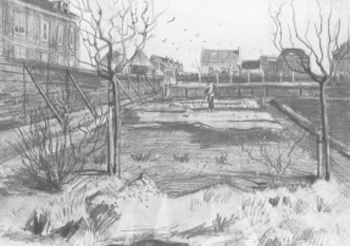 fig. 2
Vincent van Gogh, Florist's garden on the Schenkweg (F 923 JH 125), 1882, Amsterdam, Rijksmuseum ‘looking through’ he had experienced with the staked wooden posts of his frame.Ga naar voetnoot14 Recent research at the Van Gogh Museum suggests that Van Gogh continued to rely on the perspective frame while working in Paris. In Arles as well the device resurfaces as an instrument of composition and an ideal implement for artists and craftsmen. Within days of arriving, Van Gogh wrote to Theo that the modern adaptation of the perspective frame could unite artists in the same way early oil painting had allied Flemish artists like Jan and Hubert van Eyck with their Italian counterparts. He also saw the frame as an opportunity for popular painting practice, a tool of an art considered as a patient, methodical métier rather than a state of exalted, unregulated genius. Van Gogh soon began to give art lessons to his new friend, the Zouave soldier Lieutenant Milliet, training him to measure distance, proportion and to find the vanishing point by looking through the perspective frame staked in the open fields of La Crau [586/468].Ga naar voetnoot15 Van Gogh himself set to work in the Arles countryside by venturing out with his frame. As he explored the areas beyond the town walls, he was captivated by a scene with powerful Dutch overtones: pollard willows and lanes unfolding into the distance in a linear stretch of space. Roads slicing back into the distance and bounded by pollards had been a favoured subject in the drawings produced in The Hague and at Nuenen in 1882 and 1884; in 1888 Van Gogh often returned to this motif and the format of trees bending away from a strip of road as a dramatic directional marker. The perspective frame underlies the correspondences between such a pair of drawings. In the March 1888 composition Landscape with farm and two trees (fig. 3), Van Gogh recreated the pictorial structure facilitated by his device, the framed landscape. The trees bordering each side of the drawing form a passageway of optical movement into the distance, leading to the farmhouse at the horizon; the small rectangular window visible at the back directs the viewer's eye to the point of convergence | |
[pagina 51]
| |
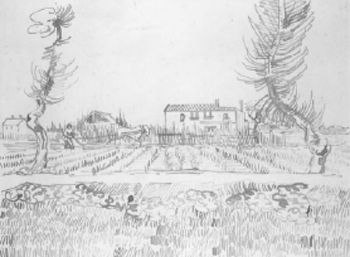 fig. 3
Vincent van Gogh, Landscape with farm and two trees (F 1517 JH 1374), 1888, Washington, National Gallery of Art as well as to the site where Van Gogh's own eye inevitably alighted as it traversed the intersecting diagonal threads of his frame. We find a very similar compositional structure in the earlier Florist's garden on the Schenkweg (fig. 2), where the flanking trees act as anchoring stations that press the eye rapidly into the distance, where it comes to rest at the small window of a building similarly disposed on the horizon plane. | |
The drawbridge seriesVan Gogh used his perspective frame to tackle another motif with more overt Dutch affinities. During his first month in Arles Van Gogh discovered a subject he regarded as ‘exactly like Holland in character’ and even considered its potential appeal for a Dutch audience: the wooden drawbridge on the Arles-Bouc canal, the Pont de Réginelle - called the Pont de Langlois after its bridge-keeper. The long alley of the canal with locks and bridge evoked for him a familiar combination of waterways punctuated by drawbridges such as those scattered through the Dutch town and country, where pedestrian and river traffic passed over and under the many bridge frames as they opened and closed in kinetic linkage. And the Arles Langlois bridge was itself originally constructed by a Dutch engineer. We are all familiar with Van Gogh's Langlois painting and it is often celebrated as both a quaint tribute to Holland and a bright allusion to Japan (fig. 4). Yet Van Gogh attached more complex and significant meanings to this subject and its setting, meanings left unexplained by these assumptions. First, he produced not one but a total of | |
[pagina 52]
| |
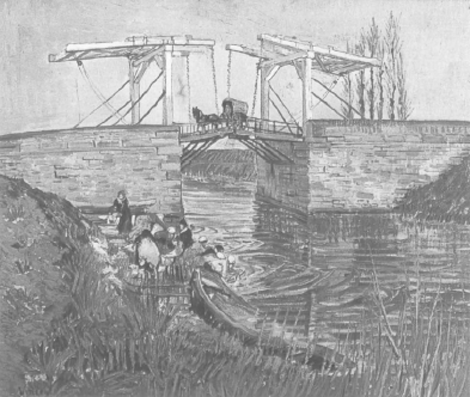 fig. 4
Vincent van Gogh, The Langlois bridge (F 397 JH 1368), 1888, Otterlo, Kröller-Müller Museum 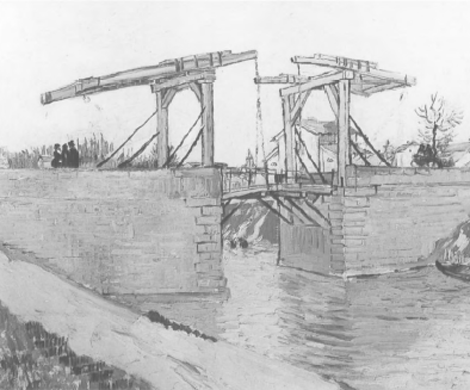 fig. 5
Detail of Vincent van Gogh, The Langlois bridge (F 400 JH 1371), 1888, Amsterdam, Van Gogh Museum (Vincent van Gogh Foundation) | |
[pagina 53]
| |
nine images of this same bridge over a six week period, depicting it from different vantage points and in a full range of media.Ga naar voetnoot16 Each one registers his absorbing interest in the structure, function and component parts of this craft mechanism in the landscape. Taken together, these images can be considered a series project exploring the construction and operation of the bridge. All the representations - even in the fluid medium of watercolour - include very clear and discernable elements of the bridge's working parts, such as hardwood uprights, cams and chain pulleys, iron supports, strapping braces and moveable diagonal frames. Paintings of bridges by the artist's contemporaries - from the wispy, indefinite shapes of his Dutch colleagues Weissenbruch and Wijsmuller to the vaporous translucence of Monet's Dutch bridges of 1874 - are very different from Van Gogh's precise and legible renderings of the drawbridge's form and function. Further, by screening his subject through the pattern of threads on his perspective frame Van Gogh visualised some of the correspondences between the mechanisms of his craft tool and the operation of the bridge frames in the landscape. This is conveyed in the way he insists upon the bridge frames' pattern of diagonal X's, which echo the patterns of his own framing device. He also uses the shape of the bridge to gauge distance, as a substitute perspective frame, as seen here in the detail of the Van Gogh Museum's canvas, where he projects a church spire through the suspended chains (fig. 5). This kind of sighting through a frame recalls one of the lessons in perspective Van Gogh had encountered in Armand Cassagne's training manual, where the artist is directed to practise fixing a distant tower through a framing device (fig. 6). The drawbridge gauging the tower recreates these framing exercises in a new site and form. The Arles bridge pictures, considered anew as a series and as a meditation on craft mechanism and mastery, can be compared to Van Gogh's earlier studies of another kind of craft frame and mechanism of interlock: the threaded looms of the Dutch weavers, painted in 1884 and 1885. In that series the artist made similar adjustments and alterations to highlight the equivalencies between the operation of his staked and threaded perspective frame and the frame and threads on the looms as manoeuvred by the weavers - the métier of art and the canut à son métier.Ga naar voetnoot17 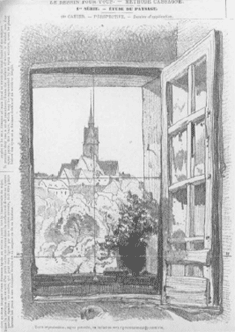 fig. 6
Armand Cassagne, Le dessin pour tous, perspective exercise, distance | |
Montmajour drawingsTo be sure, Van Gogh did not rely exclusively on his perspective frame in Arles. He also engaged in exuberant experiments in drawing and colour, signs of his increasing technical competence. Yet his departure from the perspective frame did not preclude the need for a screen. In excursions to the pilgrimage sites of Saintes-Maries-de-la-Mer and Montmajour the visual fix supplied by the physical mechanism of the frame was replaced by the operation of other types of mental filters, which acted consistently in favour of the inclusion of certain elements and the exclusion of others. In May and July of 1888 Van Gogh made a series of drawings of the vista from Montmajour, resulting in some interesting and important panoramic landscapes. | |
[pagina 54]
| |
Montmajour is the site of a ruined medieval abbey, situated at the summit of a rocky hill that overlooks what had once been flooded, muddy marshland and had become, through centuries of reclamation, the partially fertile fields of La Crau. With original buildings dating from the 12th and 14th centuries, Montmajour swarmed with Christian pilgrims during the annual Pardon of St Pierre and St-Croix; the Historical atlas of Provence, for example, highlights these pilgrimages as being of ‘particular renown’ in the region.Ga naar voetnoot18 The Montmajour abbey flourished under the Benedictine order from 1639 but was suppressed in 1786 by Louis XVI because of the involvement of its abbot, the Cardinal de Rohan, in the diamond necklace affair; in 1791 the grounds and buildings were declared national property, broken up and sold off. Left to decay for a century and a half, the cloisters, crypt and tower began to be restored by the Arles municipal authority in 1862 and this continued apace through 1889.Ga naar voetnoot19 By the time of Van Gogh's visits the site was both an integral part of the tourist itinerary and a key monument for regional identity. Guidebooks published between 1887 and 1905 highlight the historical and architectural interest of a trip there, ‘a mere 12 minutes away by train’ from the Arles rail station. Tourists were advised, for example, to attend to the fact that ‘both the monastery church and the huge crypt beneath it are in the form of a Latin cross’; to climb and study the carved parapets of the 14th-century donjon-tower; to notice the ‘large gargoyles and corbels’ visible on the original lean-to roof; and to admire the intricately carved capitals of the cloister, which include a dramatic rendering of St Martha miraculously rescuing a child from the local monster, the Tarasque.Ga naar voetnoot20 At the same time as it was claimed as a stop along the tourist route, Montmajour was reclaimed by local religious and political interests. Debates over the relocation of relics from its lower church crypt continued to rage into the 19th century, with the relics of St Anthony finally being deposited in the nearby parish church of St Julian. After 1860 Montmajour also emerged as a sacred site of Provençal regionalism. As part of his massive project to recover the autonomy and distinctiveness of Provence's language, religion and historical culture, Frédéric Mistral and his colleagues - known as the Félibres - glorified Montmajour as the royal necropolis of a non-Bourbon lineage. Along with ancient Christian relics, the abbey also housed the tombs of some of the counts of Provence, who for Mistral and his allies formed the core of a suppressed pre-modern dynasty of the south that needed to be commemorated anew. ‘At Montmajour,’ wrote Mistral, ‘our Arlesian kings sleep beneath the cloister slabs.’ To solidify the link between the region's pre-history and its contemporary renaissance, Mistral planned to hold the 1889 congress of the Félibres movement - the congress of St-Estelle - in the halls of the Montmajour abbey.Ga naar voetnoot21 The particularities of local religious and regional culture eluded Van Gogh in his encounter with Montmajour. Unlike the tourist, he walked the hour's journey from Arles rather than taking the train, and he chose the site as a place of study, surveying and drawing, noting in his letters that he visited the place no less than ‘fifty times’ during the spring and early summer of 1888 [643/509].Ga naar voetnoot22 The artist showed no interest in those elements that enticed the tourist, the pilgrim or the regional revivalist. Neither the historical layers of medieval architecture nor the crypts housing the remains of secular and sacred figures drew his attention. Instead, he was riveted by the varying views of the flat landscape below. In May and July Van Gogh produced two sets of drawings at Montmajour. He explicitly related these series to Dutch precedents and to the potential Dutch market, interspersed with what he considered the tracings of Japan and the modern landscape. The first group of seven drawings includes four panoramas looking out from the hill | |
[pagina 55]
| |
from various vantage points, yielding together a virtual circling of the promontory and the views below. Van Gogh produced a second set of five drawings of the site in July 1888. Two of these (figs. 7 and 8) were panoramic scenes of La Crau, which he considered ‘the best things I have done in pen and ink.’ Unlike the May series, which were executed rapidly, these July images were ‘finished “presentation drawings,”’ ‘substitute paintings,’ ‘exhaustively explored and carefully controlled’ [643/509].Ga naar voetnoot23 Laid out on exactly matching large sheets, when placed side by side the two pendant panoramas appear to compose a single, extensive, interlocking vista of the plains below. La Crau seen from Montmajour (fig. 7) unfolds in regular horizontal bands in a grid-like pattern towards a gentle slope at the back, marking the partial presence of the Mont des Cordes. In typical fashion, Van Gogh coaxes the viewer's eye into the picture plane by using a directional device in the mid-foreground: three rows of trees arranged as a linear runner. He renders the main area of fertile acreage in the checkerboard blocks of the middle ground. Upright pen strokes define and frame each slice of field, while the inner swaths appear raised and nubby, with a build-up of intermeshed strokes of black and brown ink that yield a ‘heightened textural effect.’Ga naar voetnoot24 The companion piece, Landscape of Montmajour with train (fig. 8), relies on a similar variety of graphic denotations in order to capture the expansive view over the fields and landscape, this time looking northwest towards the Rhône and the Alpilles mountains. This drawing includes clearer signs of human activity and its representatives than La Crau. A horse-drawn cart and rider move across to the left; two small but clearly discernable figures walk towards the viewer; a train puffs through the middle ground to the right, while behind it we find a plough and ploughman. Deft and discernable notations identify all these elements. If we look closely, for example, we can see how a witty small stroke and dash of ink are used to define a tiny pipe in the mouth of the walking man on the right; another on the back of the left-hand figure suggests a rectangular back-pack. Both are signs of an artist's équipe, and the pair may be hiking to their day's work at Montmajour, as Van Gogh himself so often did [506/642]. Van Gogh compared the flat huge plains of La Crau to those of ‘the old Holland of Ruysdael's time,’ a vista ‘like a map’ and ‘as beautiful and infinite as the sea.’ His inclusive view and splayed, rectangular fields have been likened to similar elements in Ruysdael's View of Haarlem, although the former lacks the ‘masses of clouds’ that dominate Ruysdael's depiction of the northern skies.Ga naar voetnoot25 The La Crau panorama also evokes the model of another 17th-century painter Van Gogh often recalled in Arles, Philips de Konink, whose works - such as his 1655 Distant view in Gelderland - are the perfect illustration of what art historian Svetlana Alpers has called the peculiarly Dutch practice of the ‘mapped landscape,’ where a ‘vast continuum of land’ gives way to a ‘seemingly endless’ stretch of plains expanding simultaneously both laterally and into depth.Ga naar voetnoot26 Two types of selective vision are thus at work in Van Gogh's Montmajour series. The first group of drawings, circling the hill, reveals his pattern of inattention to the complex of sacred buildings that provided the major attraction for other visitors to the site. He produced his series either with his back to the abbey complex or included it only as an incidental geometric shape in the landscape, divested of its signifying Catholic symbols and carvings. The July drawings suggest a second type of transformation. An unavoidable and imposing element of the terrain Van Gogh would have observed from Montmajour was the Alpilles mountain range, which lines Provence between Avignon and Arles with jagged crests reaching some 400 metres. Van Gogh did not screen out the mountains altogether but he tends to diminish their size, scale and prominence as defining features of the landscape. In celebrating the two large panoramas as his ‘best in pen and ink,’ for example, he selected those vistas that minimise the mountainous topography most sharply. The landscape of Montmajour with train (fig. | |
[pagina 56]
| |
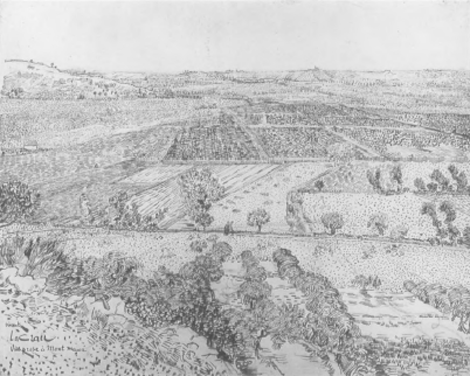 fig. 7
Vincent van Gogh, La Crau seen from Montmajour (F 1420 JH 1501), 1888, Amsterdam, Van Gogh Museum (Vincent van Gogh Foundation)  fig. 8
Vincent van Gogh, Landscape of Montmajour with train (F 1424 JH 1502), 1888, London, British Museum | |
[pagina 57]
| |
8) slips in a hint of the Alpilles, cut off at the very back right corner of the composition, where they receive a lightly hatched pen treatment that allows them to emerge as a delicate pair of two low-lying triangles, less like mountain peaks than gentle mounds in the far distance. Van Gogh closes off the scene at the right, just at the point where the Alpilles begins to unfold in its chain, forming a succession of massive limestone promontories markedly circling the area. In the mapped companion drawing, La Crau seen from Montmajour (fig. 7), Van Gogh concentrates on the view that conforms most closely to a Dutch panorama; while the slope of the Mont des Cordes is partly discernable at the left, the visual cues and traces of an Arlesian geography defined and ringed by mountain summits are conspicuously absent. These strategies of exclusion and minimisation were confirmed when Van Gogh wrote to his sister Wil some weeks after completing these drawings that he wanted to travel further in southern France, to where the country was ‘not so flat - seeing that, in point of fact, I never saw a mountain in my life’ [671/W6]. The vista from Montmajour does offer mountains, but Van Gogh's powerful filters rendered them inapprehensible. And when he does include them, the rugged Alpilles crags appear as diminutive arcs similar to the dunes marking distant Dutch horizons. | |
Paul Gauguin's visionary Brittany, 1888When regionalist leader Frédéric Mistral surveyed the spectacle of Montmajour he saw an exalted space, distinctive to his native Provence, a space of ‘biblical hills,’ suffused with an ‘aroma and aridity that intoxicated hermits and created mirages.’Ga naar voetnoot27 Van Gogh observed this same scene and discovered a panoramic landscape ‘like a map,’ evoking not a vision of solitary biblical hermits but a tableau of cultivated terrain, peopled by human figures and their vehicles and similar to a Dutch vista by Ruysdael or Konink. At the same time, his friend and colleague Paul Gauguin, closer in many ways to Mistral's visionary cast of mind, was setting to work in the Breton village of Pont-Aven amidst a profusion of peasant devotional ritual and pilgrimage processions and responding avidly to precisely those occasions that Van Gogh scrupulously avoided in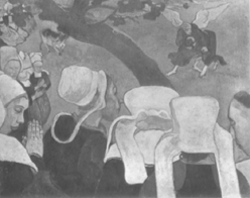 fig. 9
Paul Gauguin, The vision after the sermon: Jacob wrestling with the angel, 1888, Edinburgh, National Gallery of Scotland Provence. In this Breton environment Gauguin created what he considered a major breakthrough for modern painting, a work he once contemplated calling The apparition but eventually titled Vision after the sermon, Jacob wrestling with the angel (fig. 9). Upon its completion Gauguin hoped to donate the painting to the local church, where he thought it would fit well with the ‘bare stone and stained glass.’Ga naar voetnoot28 Gauguin linked both the form and content of The vision to his credo that art was an abstraction, a glimpse of an ethereal dream-like state, liberated from the shackles of tawdry earthbound matter in a flight to metaphysical mystery. He expressed this credo by choosing to paint a visionary state, a state whose contours he had encountered during his little-studied formation in a French Catholic seminary, and enriched through his associations with neo-Platonist and idealist colleagues in the Parisian avant-garde. In the painting, Gauguin explores shifting levels of reality by dividing the canvas into what art historians have always called the physical and psychic halves of the picture, but also by a number of lesser-known technical strategies that dematerialise the physical surface of the | |
[pagina 58]
| |
canvas: he employs a thinned and light oil paint; devises a smooth, single field of non-natural background colour, with minimal surface texture and unbroken brush marks; and he exposes the ground of the canvas through a chalky, matte whiteness in the foreground which resembles the effects of a fresco.Ga naar voetnoot29 In his later work, Gauguin would continue to develop technical procedures to diminish the physicality of his canvases, formalising his persistent effort to attenuate materiality and to weaken its hold on consciousness. His art, paradoxically, aimed to release the contours of an ideal, non-corporeal realm through the use of pigment and primer on canvas. By contrast, from his earliest days Van Gogh had absorbed powerful cultural barriers to idealism from his Dutch Reformed Calvinist theology and education, which would later underlie some of the profound and irreconcilable tensions in his relationship with Gauguin. These discordant cultural codes also help us understand why Van Gogh could never follow his friend in his quest for what he called the ‘phantom ship of the dream,’ an art liberated from the model, from the embededness of earthbound matter and from the physical density of the image. Instead, Van Gogh pursued an art of maximal texture and materiality, working the image of work into the canvas, a process he likened to weaving and ploughing. If Gauguin aspired to the immateriality of the fresco, Van Gogh aimed to create a formal equivalent to the productive craft labour of a woven kitchen towel or a piece of coloured earthenware. For him, painting was a process of ‘agir-créer,’ action painting of labor figures in action. This type of image-making as enacted faith was far removed from Gauguin's ideal of the sacred world evoked through the opaque, planar forms of fresco painting. Gauguin exhorted Van Gogh to smooth over and thin out what he contemptuously called his friend's vigorous ‘tripotages’ of paint - those messy accidents, the thickly loaded and broken surface crusted with pigment and visible brush marks. These, to Gauguin, a lapsed but tormented Catholic, were traces of what he saw as ‘sullied,’ perfidious nature, a weighted muck and mire that impeded the artist's release from deficient material reality into the ineffable netherworld of the divine.Ga naar voetnoot30 Gauguin's foray into religious subjects and an art of abstraction, combined with similar impulses on the part of Emile Bernard, would position Van Gogh on the fig. 10
Vincent van Gogh, La berceuse (F 508 JH 1671), 1888/89, Boston, Museum of Fine Arts, bequest of John T. Spaulding horns of a dual dilemma. Not only was he surrounded in Arles by what he considered the archaic practices of a miraculous Christianity, but his closest colleagues in the avant-garde were also turning to a particular form of religious art. This twofold challenge necessitated other responses than the posture of negation so characteristic of his first months in the south. During and after the period of his difficult collaboration with Gauguin, Van Gogh would consolidate a new position, formed in stated and unstated dialogue with the dynamic supernaturalism he encountered in social and avant-garde practice. Moving from negation to naturalisation, he would come to locate in a certain kind of depiction of the human figure a powerful humanist alternative system of meaning which we might call a Protestant counter-imagery. This constituted an art of sacred realism, shorn of miraculous interventions and visionary ruminations but nonetheless vested with spiritual force and the functions traditionally associated with religious art. | |
[pagina 59]
| |
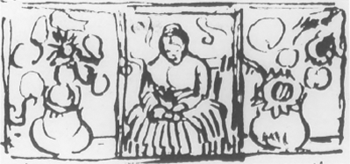 fig. 11
Vincent van Gogh, Sketch in letter 778/592, showing La berceuse as a triptych with flanking sunflowers, c. 22 May 1889, present location unknown During the months when Gauguin painted his Breton Vision, Van Gogh produced his Sower, rendering what he referred to as ‘the longing for the infinite’ [630/B7] in a peasant figure in action, seeking in the roughness, density, palpability and fibrous texture of the canvas the pictorial equivalents of the clods of earth and physical exertion depicted. In contrast to Gauguin's tactics of dematerialisation, evocative of the fragile indeterminacy of the ideal, Van Gogh proceeded by forms of re-materialisation, naturalising divinity in the service of ‘rendering the infinite tangible’ [651/B12].Ga naar voetnoot31 | |
‘La berceuse’ and sacred realismVan Gogh's developing project for a secular devotional imagery, what can be called his emerging ‘sacred realism,’ nourished by long-term legacies and sparked by the short-term challenges of avant-garde and populist French Catholicism, culminated in his series of portraits of Madame Augustine Roulin as a cradle rocker, La berceuse (fig. 10). In letters to Theo and Bernard, he described these paintings as agents of rest, comfort and consolation, qualities associated with traditional religious art, particularly for sailors, who - Van Gogh suggested - could conjure such a reassuring image of a mother rocking a cradle as they pitched and swayed on the waves [747/574].Ga naar voetnoot32 In his series, Van Gogh evoked and transposed scenes from Pierre Loti's novel Le pêcheur d'Islande, in which sailors engaged in the talismanic practice of summoning supernatural assistance from a figurine of the Madonna on board their ship. Van Gogh assigned the source of their solace and fortitude to the visual memory and image of a real mother singing to her baby.Ga naar voetnoot33 Van Gogh deepened the sacred realism of these portraits by characterising La berceuse as a modern equivalent of early Christian saints and holy women, ‘saints et saintes femmes’ [802/605]. He devised the work as the possible central panel of a triptych (fig. 11), flanked by glowing beacons of sunflowers, which he described as symbols of gratitude and claimed conveyed similar effects to those of stained glass windows [778/592].Ga naar voetnoot34 According to Bernard, Van Gogh | |
[pagina 60]
| |
proposed setting the triptych in a tavern at Saintes-Maries-de-la-Mer or Marseilles, where sailors coming and going from rough seas could be inspired and heartened by the work's crude and radiant colours, interlinked forms and familiar and humble subject.Ga naar voetnoot35 In giving a triptych form and consolatory function to his painting Van Gogh was not simply substituting one kind of religious imagery for another. New evidence from local sources suggests that La berceuse represents a dynamic and creative adaptation of particular elements of Catholic popular piety uniquely available to Van Gogh during his time in Provence, elements that helped shape the form, meaning and function of the paintings. First, Van Gogh began working on La berceuse during the Christmas weeks of 1888, a period of particularly vibrant popular Nativity culture in Arles. The local market was lined with stalls selling ceramic figurines called santons, which feature a variety of male and female types - from the cheese seller and spinner to the broom seller and knife grinder - to be placed in family crèches alongside the Holy Family in the stable manger. These Provençal santons came to life in annual theatrical versions of the Nativity known as pastorales, which combined farcical comedy with anachronistic miraculous witnessing as local characters such as peasants, artisans, municipal officials and gypsies were shown making their way to welcome the baby Saviour. Although he did not fully understand the Occitan dialect, Van Gogh went to the Folies Arlésiennes in early January of 1889 to see such a play, the Riboun Pastorale, a Nativity ‘comic-opera in 5 acts.’Ga naar voetnoot36 The combination of music, pantomime, special effects and spectacle made the story generally comprehensible. Van Gogh was deeply affected by the music, writing to Theo of the stirring singing of the ‘amazing’ ‘old peasant woman’ at the cradle of the newborn Jesus in the last scene of the play [747/574].Ga naar voetnoot37 The letter in which Van Gogh describes this pastorale and his reactions is also the one in which he describes the third version of La berceuse, expressing his idea that the canvas might convey solace for sailors in their isolation, elicit a ‘sense of being rocked’ and recall ‘childhood lullabies.’ The Arles pastorale offered at this critical moment in the evolution of La berceuse a theatrical version of a modern sacred Nativity, culminating in a scene of collective redemption at the baby's cradle. The musical climax of the play and the wondrous voice of the woman singing to the baby may also have triggered his associations of the musicality of La berceuse as an agent of consolational form. Van Gogh's combined allusion of La berceuse to sailors, early Christian saints and holy women and the setting of Saintes-Maries-de-la-Mer or Marseilles also has a distinctive and historically-specific meaning and resonance. Both of these coastal towns were centres of dynamic 19th-century matriarchal Christian cults linked to the lives and fates of sailors at sea. The pilgrimage town of Saintes-Maries-de-la-Mer - also known as Notre Dames de la Barque or ‘Our Ladies of the Boat’ - celebrated the miraculous landing of the two Marys and St Sarah at the dawn of Christianity. The statuettes and model boat of the female saints were elaborately decorated and launched in the massive annual ceremony completed just five days before Van Gogh arrived to work there at the end of May 1888, having hired a coach service specially run for the duration of the pilgrimage.Ga naar voetnoot38 The visual culture of the town of Saintes-Maries - including prints, postcards, paintings and figurative arts - was dominated by the presence and miraculous agency of the female saints in their celestial ship. The churches at both Saintes-Maries-de-la-Mer and Marseilles contained some of the largest collections of ex-voto paintings in Provence, a genre of popular religious art that offered thanks to a saint or the Virgin for acts of deliverance from earthly misfortune or accidents. A special type of nav- | |
[pagina 61]
| |
igational ex-voto commemorating the rescue of sailors from shipwrecks or storms at sea proliferated at Saintes-Maries and Marseilles, often depicting the intervention of heavenly protectors from the skies above in keeping vessels from destruction in the seas below (fig. 12).Ga naar voetnoot39 Van Gogh's La berceuse triptych also joined a symbol of gratitude to a sanctified maternal figure who offered solace to sailors. This was gratitude not for already accomplished and presumed supernatural acts involving the miraculous reversal of the order of nature, but gratitude for comfort and consolation that was provided by human agents on earth in companionship and hope, divested of expectations of direct celestial intrusion. But the presence and power of local Provençal materials suggests that Van Gogh pressed particular elements of Catholic popular piety, theatre and images into the service of his Protestant, modernist religious realism, affirming a new art as materialist embodiment, an object of exchange and communication, and an emanation of divinity in and through nature and the redemptive interdependence of corporate community. Van Gogh's Arles work extends the technical practices and theological framework of his Dutch formation, yielding an art that screened the bright colours and Catholic culture of Provence through the filters of craft labour and Protestant humanism. As we welcome the exhibition ‘Van Gogh and Gauguin: the studio of the south,’ visitors are urged to discover the signs of mechanism, weaving and secular devotion that set the Dutch minister's son apart from his Parisian symbolist colleague. Weaver and dreamer linked modern painting to different forms of divinity. 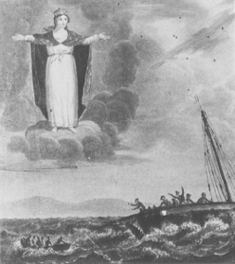 fig. 12
Detail of a navigational ex-voto, Antibes, Notre-Dame de Bon-Port |
|

